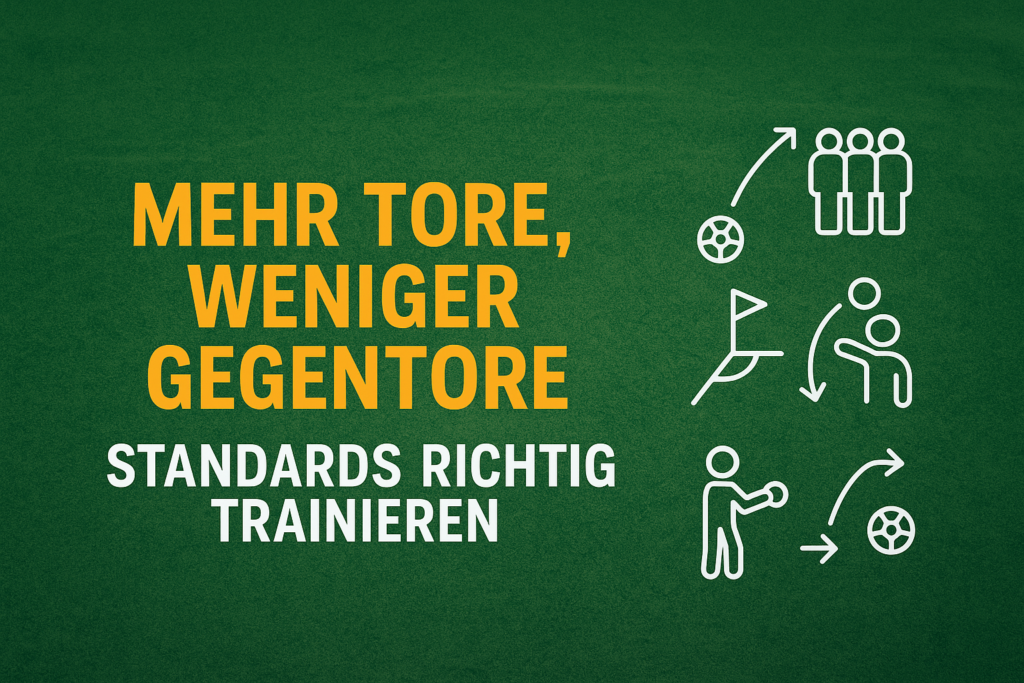
Set piece scenarios such as corners, free kicks, throw-ins and even indirect free kicks are among the decisive moments in football. They are not only opportunities for quick goals, but also critical points at which games can turn - in both a positive and negative sense. An unsuccessful free kick or a poorly defended corner can be just as decisive for victory or defeat as a perfectly executed move after a throw-in.
It is therefore all the more important that set-piece situations are not trained in isolation, but rather holistically - with a view to both phases of the game: Attack and defence. When offensive and defensive roles are trained in the same exercises, everyone involved benefits: attackers learn to assert themselves against real resistance, defenders improve their behaviour under real pressure. At the same time, the tactical understanding of the dynamics of such situations increases, leading to quicker decisions and better teamwork.

Set-piece situations require clear sequences, precise execution and coordinated running routes. Every player must know and internalise their role in order to successfully attack or defend against set pieces.
The forms of training presented here show in a practical way what systematic set-piece training can look like - with clear processes, defined roles and immediate feedback for both sides. This not only trains individual technique, but also strengthens collective coordination within the team. The alternation between different formats is particularly valuable: from targeted drills (e.g. direct free-kick with wall) to sequences similar to match formats (e.g. throw-in with transition movement).
Important principles:
Objective: To improve the shooting technique and accuracy of the attackers and the positioning of the defenders and goalkeeper.
Set-up:
Procedure: Each kicker takes it in turns to take five free kicks.
Objective: Fast attacking actions and precise combination play under pressure as well as fast defensive reactions and blocking shots.
Set-up:
Procedure:
Objective: Optimisation of offensive running routes and precise corner kick execution as well as defensive spatial coverage and efficient clearing actions.
Set-up:
Procedure:
Objective: Effective switching and quick decision-making in throw-in situations for both teams.
Set-up:
Procedure:

With REPLAY can be used to analyse set-piece situations in a detailed and structured way. Coaches can mark relevant scenes from matches or training sessions, comment on them visually and compile them into playlists for individual or team analyses. For example, repeated mistakes in wall positioning, imprecise running routes at corner kicks or coordination problems at indirect free kicks are visualised and discussed in detail. REPLAY makes tactical standard work understandable, comprehensible and effective in the long term.
With zone14 LIVE , matches and training sessions focusing on set-piece situations can not only be streamed automatically and in high quality, but also analysed in real time. Coaches can immediately react to repeatable patterns during the game with the help of the live broadcast - for example, if running routes at corners are not coordinated or free kicks are not executed as rehearsed. The ability to make tactical corrections directly at half-time or even during short interruptions based on what has just been seen in the live stream is particularly valuable. This ensures immediate feedback and quicker implementation during the match.
STATS analyses how players behave physically in set-piece situations: Who sprints to the short post at a corner? Who consistently positions themselves incorrectly at free kicks? How many intensive runs are made during set-pieces in the final phase of play? By recording running routes, speeds and movement profiles, STATS provides objective data that is linked to specific video sequences. This creates a new understanding of efficiency, commitment and tactical discipline during set pieces.
Set-piece situations are increasingly deciding the outcome of matches. Systematic training that involves both offence and defence is needed in order to use them consistently and defend safely at the same time. The exercises presented create realistic game situations in which both parts of the team are challenged and encouraged at the same time - technically, tactically and in teamwork.
The targeted use of technologies such as zone14 REPLAY for video analysis, LIVE for real-time observation and STATS for objective performance evaluation makes standard training even more effective. The result is a modern training concept that not only trains standards, but also understands them in depth and develops them in a targeted manner - for tangible improvements on the pitch. zone14 REPLAY zur Videoanalyse, LIVE zur Echtzeitbeobachtung und STATS zur objektiven Leistungsbewertung wird das Standardtraining noch wirkungsvoller. So entsteht ein modernes Trainingskonzept, das Standards nicht nur trainiert, sondern auch tiefgreifend versteht und gezielt weiterentwickelt – für spürbare Verbesserungen auf dem Platz.